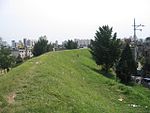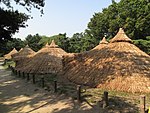Pungnaptoseong

Earthen Fortification in Pungnap-dong, Seoul (Korean: 서울 풍납동 토성; Hanja: 서울 風納洞 土城; RR: Seoul Pungnap-dong toseong) is a flat earthen wall built at the edge of the Han River in Korea. It has a circumference of 3.5 km. It is located in modern-day Pungnap-dong, Songpa-gu, Seoul. It used to be included in the neighboring city of Gwangju. It has a long oval shape, spreading to north and south, and leaning slightly toward the east. Based on research conducted during the Japanese occupation, it has been speculated that Pungnap Toseong was Hanam Wiryeseong, the first capital of Baekje.Only 2.7 km of its walls remain. Including the west wall, which had been destroyed by flooding, its circumference reaches about 3.5 km and its area nearly 859,508 m2. After constructing this central part, the inner wall, mainly composed of sandy soil, grit, clayish soil and muddy soil, was set up by heaping earth at a slant. On the top of the last earthen layer of the inner wall, pebbles were laid in three layers and trimmed stones were piled up inside 1.5 m high with mud prepared from natural soil, and by piling up the central part in trapezoid shape whose lower part is 7m wide and 5m high.
Excerpt from the Wikipedia article Pungnaptoseong (License: CC BY-SA 3.0, Authors, Images).Pungnaptoseong
Pungseong-ro 22-gil, Seoul Pungnap 2(i)-dong
Geographical coordinates (GPS) Address Nearby Places Show on map
Geographical coordinates (GPS)
| Latitude | Longitude |
|---|---|
| N 37.530266666667 ° | E 127.1162 ° |
Address
풍성로22길
Pungseong-ro 22-gil
05528 Seoul, Pungnap 2(i)-dong
South Korea
Open on Google Maps










